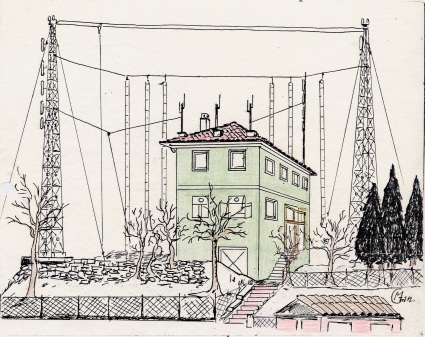Special MRD station – Trieste Radio c/s IQX
Dear Sparks
On the same way of last years, during April 14 and 15 – 2017, II3IQX will be active during Maritime Radio Day, renewing QSO’s with HAM community, and former operators of the Maritime Mobile Service, after ceasing the use of Morse code.
The story of IQX “TRIESTE RADIO”
After the end of W.W.II, Trieste coastal radio station was created to grant radio communications in the Adriatic Sea, owing increase of commercial exchanges and technical evolution.
The town of Trieste was enclosed in the T.L.T. (Free Territory of Trieste), from 1946 until 1954 (DXCC: i1 – Trieste, deleted).
British Major Haiworth, at time Post and Telegraph Director in charge of Anglo-American Administration, in accordance with local PPTT Supervisors, obtained the opening of the new station: the assigned call sign, with “I” was confirmed, and become hopefully for the final solution of the geo-political situation.
First headquater was inside “Lanterna” lighthouse, the old phare-pillox situated at the end of bank, in the town.
For a short time, the station thence was situated inside the old “San Giusto Castle”, but during 1953 begin construction of the new bulding, in order the receiver site must be separated from the transmitter.
The receiving location is on acreage on the route from Trieste town to Opicina, in dominant position and open to the gulf, advantageous for radiocommunications and served by public transport service.

The transmitting location is some Km. nearby, on hill called “Monte Radio”, proximity of RAI broadcast transmitters.
The bulding of receiving section increased during next decade on the top floor, allowing more space for administration and technician offices and changing room.
During 1983 some more works like ‘insonorization’ and the change of fixtures increase comfort of workers.
First equipment was receivers BC348 and transmitters BC610 operating 500 KHz, and OC5 Marconi running 5 KW for short wave 8 MHz.
During 1953 begins service on 2182 KHz phone and HF on the bands 4, 6, 8, 12, 16 and 22 MHz for long distances.
More receivers in service during sixties: Magneti Marelli RP32, Hallicrafters SX28, RCA AR88, Marconi, Siemens and Allocchio Bacchini.

During the 70’s new receivers was Collins 51S1, during the 80’s Dancom, Elmer and Collins 651S1; during the 90’s Rohde & Schwarz.
The 1993 management changes from PPTT to IRITEL and then Telecom Italia.
MF/CW is separated in a “closet”, and the operator follows 500 KHz of IQX and IPA/Anconaradio.
CIMAT system expect multiple operating desks: they was added the remote-controlled stations phone 2 MHz and VHF of San Benedetto del Tronto radio/IQP, of Anconaradio/IPA, of Veneziaradio/IPN and Ravennaradio VHF.
Started also ‘autolink’ communications.
One room is devoted to telex equipments, another room is for automatic keyers devices and emergency power suppliers.
Receiving antennas are always vertical dipoles or orizzontal Marconi-types, supported by two pillars.
VHF aerials are settled just over building, mainly collinear type.
Transmitter site was equipped with Elmer and Marconi running 5 KW, Philips running 2 KW and a ‘biconical’ antenna with tuner, permitting emissions of two or more HF frequencies simultaneously on the same aerial.
During first years, the operators coming from the Telegraph section of PPTT , or from the old national centre of Coltano, with big experience, even in the navy service.
Other personnel coming from the ex-operators of GMA Police, after his dissolution during 1954.
During ’70s, following PPTT competitions, begun service some ship’s Radiofficers. During ’80s, other PPTT competition, and new operators replaces the retirees.
When there was no sufficent operators, some guys started service for three months once a year, usually Radiofficers from freighters.
With Radiotelegraphists and Radiotelephonists, there was employers for teletype, electronic laboratory, administratives and a director.
In the transmitter building they operate technicians and a responsible.
Watch service for safety of life at sea granted continously, with turns on 500 KHz, 2182 KHz and VHF channel 16; HF bands was followed from 1 to 5 operators, according to the timetable, opening of the band and traffic volume of the moment.
A supervisior follows all operations..
Traffic lists sent MF CW and Phone, but in HF follows IAR and ICB on the same IAR/Romaradio schedule.
Furthermore original QTC’s traffic, often made QSP traffic,delivering onboard messages from other italian coastal stations.
HF operators was particularly patience when receiving QTCs from ships in difficulty with low-power transmitters, defective manual keying, long messages or with problematic positions.
On the rearwall of receiving room there was a world map, where remote areas of the Pacific Ocean was not represented. At the end of a difficult QSO, one operator may said:” I just made a contact outside the world!”.
Starting ’80s, Adriatic sea yacht traffic increases, and new VHF repeater of Monte Piancavallo (PN) helps with communications in the Dalmatia and Istria coasts areas, otherwise not covered.
Triesteradio’s operators was like a big familiy: they do their best to complete their duty, even helping one another, without exception of rule or frequency assigned at the moment.
After 1996 remoted reorganization, ex-workers and friends of Triesteradio meet themselves yearly once again to stay toghter.
Thanks to R/O Giancarlo D’Italia: during last years he wrote the little book ‘IQX short history’: he resumed photos and informations from old officemates, and from his personal experience, where i got most part of these informations, besides my own personal remembers.
73’s
Radio Officers Ennio A. Di Tomaso c/s IV3EAD
